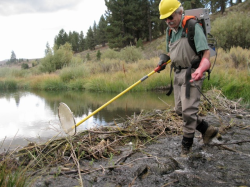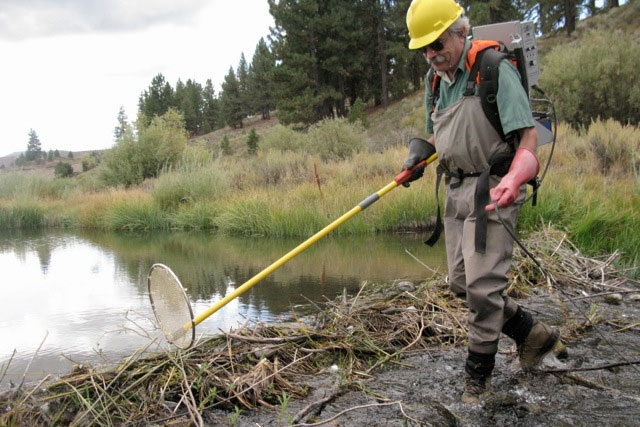
Jacob Katz, UC DavisLead researcher Peter Moyle studying native fish in the Sierra Nevada.
Cold-water-loving fish will find California’s rivers and streams to be increasingly inhospitable — and deadly.
A study published in the online journal PLOS ONE finds that rising water temperatures may drive many of the state’s native species extinct, while helping invasive fish flourish. From the study:
Most native fishes will suffer population declines and become more restricted in their distributions; some will likely be driven to extinction. Fishes requiring cold water [less than 72 degrees] are particularly likely to go extinct. In contrast, most alien fishes will thrive, with some species increasing in abundance and range.
The peer-reviewed study by fishery experts at UC Davis created a framework to measure how vulnerable numerous species are to climate change. It assesses habitat conditions, climate change projections and temperature sensitivity for the 121 native and 50 nonnative fish species that inhabit California.
It found that 82 percent of the native species are at risk of extinction in the next 100 years, largely because climate change will make water temperatures too warm. For nonnative fish, which are generally more adaptable to warm water, only 19 percent are likely to die off.
From a UC Davis press release:
“If present trends continue, much of the unique California fish fauna will disappear and be replaced by alien fishes, such as carp, largemouth bass, fathead minnows and green sunfish,” said Peter Moyle, a professor of fish biology at UC Davis who has been documenting the biology and status of California fish for the past 40 years. …
Climate change and human-caused degradation of aquatic habitats is causing worldwide declines in freshwater fishes, especially in regions with arid or Mediterranean climates, the study said. These declines pose a major conservation challenge. However, there has been little research in the scientific literature related to the status of most fish species, particularly native ones of little economic value.
Moyle saw the need for a rapid and repeatable method to determine the climate change vulnerability of different species. He expects the method presented in the study to be useful for conservation planning.
“These fish are part of the endemic flora and fauna that makes California such a special place,” said Moyle. “As we lose these fishes, we lose their environments and are much poorer for it.”



